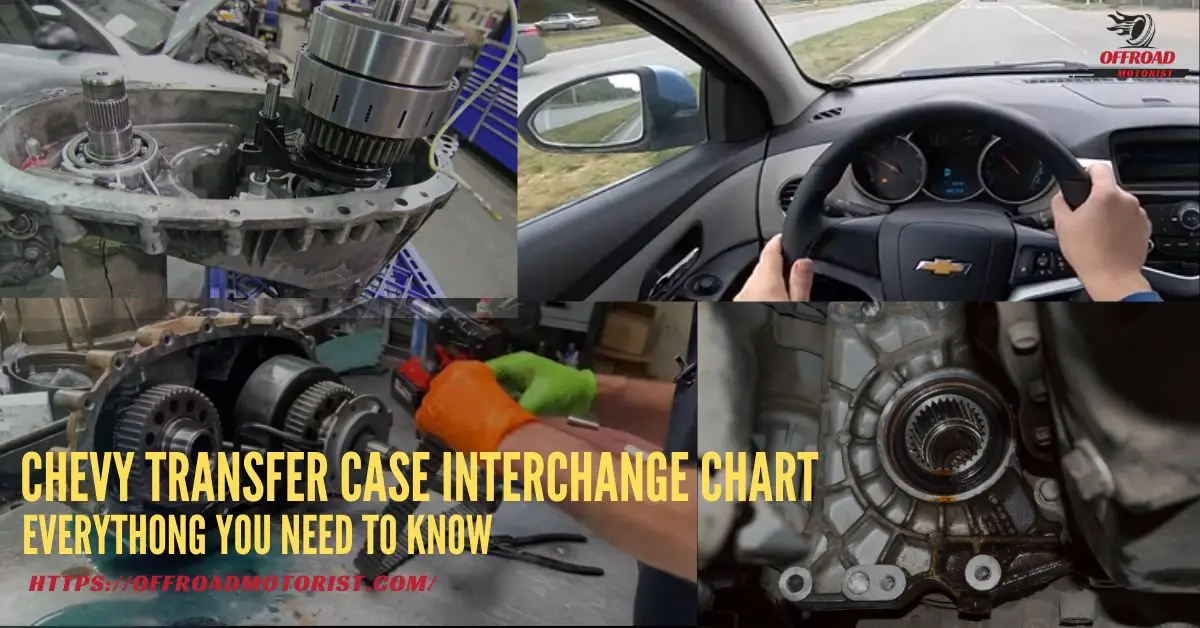Chevy Silverado Not Shifting Gears? Let’s Solve The Problem Together [05 Easy Steps]
Chevy Silverado not shifting gears? Following the steps discussed in this post, you can troubleshoot and repair gear-shifting problems confidently.
The Chevy Silverado is a popular and reliable truck, but even the most dependable vehicles can experience issues. One common problem that Silverado owners may encounter is difficulty shifting gears.
Symptoms of this problem include delayed shifting, harsh shifting, and gears slipping. This post will outline a step-by-step process for identifying and fixing gear-shifting problems in the Chevy Silverado.
From checking the transmission fluid level to inspecting the transmission control module, we will cover the most common causes and solutions for this issue.
06 common causes of gear-shifting problems in Chevy Silverado
Here are 06 common causes of gear-shifting problems in Chevy Silverado:
- Low transmission fluid level can cause the gears to grind or slip, preventing the transmission from shifting gears properly.
- Worn or damaged gears in the transmission can also cause difficulty shifting gears. A lack of proper maintenance, heavy use, or vehicle age can cause this.
- A faulty transmission control module (TCM) can also cause shifting problems. The TCM controls the shifting of the gears; if it malfunctions, it can cause the transmission to shift erratically.
- A clogged transmission filter can also cause shifting problems as it can reduce the pressure of the fluid in the transmission, which can cause the gears to slip.
- A problem with the transmission solenoids or sensors can cause the transmission to shift incorrectly or not shift at all. These components control the flow of transmission fluid, and if they malfunction, it can affect the shifting of gears.
- A worn clutch or pressure plate can also cause shifting issues. The clutch and pressure plate are responsible for engaging and disengaging the gears; if worn or damaged, it can make it difficult to shift gears.
Symptoms of gear shifting problems in Chevy Silverado
Signs that a Chevy Silverado is having trouble shifting gears include:
Slipping shifting gears
When the transmission cannot engage a gear properly, causing the engine to rev without the vehicle accelerating, slipping gears can be caused by various issues, such as low transmission fluid level, worn clutch or gear synchronizers, or problems with the transmission control module.
It can also indicate a more serious problem, such as a damaged transmission
Delayed shifting the gears
This occurs when there is a lag between when the gear shift lever is moved and when the gear change takes place. Delayed shifting can be caused by low transmission fluid level, dirty or clogged transmission filters, worn transmission control modules, or problems with the transmission control solenoids.
The “Check Engine” light appears on the dashboard
The “Check Engine” light is a general warning light that can indicate a variety of problems with the vehicle, including transmission problems. When the light comes on, the vehicle’s onboard computer has detected a problem with one or more of the vehicle’s systems.
In case of transmission issues, the computer may detect a problem with the transmission control module, the transmission control solenoids, or with one of the sensors that monitor the transmission’s operation.
This light can also indicate other issues with the vehicle, and it should be scanned for trouble codes to determine the cause.
Hard shifting the gears
Hard shifting can occur when the gears are not shifting smoothly and is usually caused by a lack of lubrication, worn or damaged synchronizers or gears, or a problem with the transmission control module.
A low transmission fluid level, a clogged transmission filter, or a worn clutch can also cause it. Hard shifting can be more pronounced when the vehicle is cold, and it can cause more wear and tear on the transmission if not addressed.
Grinding or whining noise coming from the transmission
Grinding or whining noise coming from the transmission can indicate a serious problem with the transmission. Grinding noise could indicate that the gears are not meshing properly, which could be caused by worn or damaged gears or synchronizers.
Whining noise could be caused by worn bearings or low transmission fluid level. Other problems, such as a failing clutch or a damaged torque converter, can also cause these noises.
Leakage from transmission
Leakage from the transmission can be caused by a damaged or loose transmission pan, worn or damaged seals, or a problem with the transmission cooler lines.
Transmission fluid is an essential component for lubrication. Malfunctioning transmission operation and leakage can lead to low transmission fluid level, which can cause hard shifting and slipping gears.
Difficulty in selecting a gear
Difficulty in selecting a gear can be caused by problems with the transmission control module, the transmission control solenoids, worn or damaged gears or synchronizers, or a problem with the shifter or linkage.
Warning message on the dashboard
A warning message on the dashboard related to the transmission can indicate a problem with the transmission system. These messages can vary depending on the make and model of the vehicle, but they often include phrases such as “check transmission,” “transmission fault,” or “service transmission.”
These messages usually indicate that the vehicle’s on-board computer has detected a problem with one or more of the transmission’s systems.
Warning chime sound
A warning chime sound related to the transmission can indicate a problem with the transmission system.
These chimes are usually accompanied by warning messages on the dashboard and can indicate a problem, such as a low transmission fluid level, a problem with the transmission control module, the transmission control solenoids, or worn or damaged gears or synchronizers.
How to troubleshoot gear-shifting problems in Silverado?
The solutions to troubleshoot the problem of a Chevy Silverado having trouble shifting gears can vary depending on the specific issue causing the problem. Follow these steps for possible solutions:
Step 1: Check the Transmission Fluid Level
The first step in troubleshooting gear shifting problems in the Chevy Silverado is to check the transmission fluid level. The transmission fluid is responsible for lubricating the transmission and other internal components.
It also helps to cool the transmission and transfer power to the wheels. Maintaining the proper fluid level is essential for smooth gear shifting and transmission health.
The steps for checking the transmission fluid level in a Chevy Silverado are as follows:
- Park the vehicle on level ground and turn off the engine.
- Locate the transmission dipstick, which is usually located near the back of the engine and may have a yellow or orange handle.
- Remove the dipstick and wipe it clean with a rag.
- Reinsert the dipstick and remove it again to check the fluid level.
- Compare the fluid level on the dipstick to the “full” and “low” indicator marks. The fluid level should be between these two marks.
- If the fluid level is low, add transmission fluid as necessary. Be sure to use the correct type of transmission fluid for your specific make and model of Silverado.
- Check the fluid level when the engine is cold, and the vehicle is parked on level ground.
If the fluid level is low, add transmission fluid as necessary. It is important to use the correct type of transmission fluid for your specific make and model of Silverado.
Refer to your vehicle’s owner’s manual or consult a professional for the recommended type and amount of transmission fluid. If the fluid level is low, it might indicate a leak, so it’s important to keep an eye on the fluid level and look for signs of external leaks.
It’s also important to check the fluid level regularly as part of regular maintenance to prevent issues related to low fluid level.
Step 2: Inspect the Transmission Filter
If checking the transmission fluid level and adding fluid as necessary does not resolve the gear-shifting problem, the next step is to inspect the transmission filter.
The transmission filter removes debris and contaminants from the transmission fluid, and a dirty or clogged filter can negatively impact gear shifting.
The steps for inspecting the transmission filter in a Chevy Silverado are as follows:
- Locate the transmission filter, which is usually located near the transmission pan. The location of the filter may vary depending on the make and model of your Silverado, so refer to your vehicle’s owner’s manual for specific instructions.
- Use a socket wrench to remove the pan and access the filter.
- Carefully remove the filter from the transmission.
- Inspect the filter for any signs of dirt, debris, or clogging.
- Compare the filter to a new one; if it appears dirty or clogged, it should be replaced with a new one.
- Clean the pan and gasket and reinstall the pan and filter.
- Add new transmission fluid as necessary
A dirty or clogged filter can cause various issues, including delayed shifting, harsh shifting, and even gears slipping. If the filter appears dirty or clogged, it should be replaced with a new one.
Changing the filter should be done by a professional as changing the filter may require special tools and knowledge of the transmission system and can also risk making the problem worse if not done correctly.
Step 3: Check for External Leaks
If inspecting the transmission filter does not reveal any issues, the next step is to check for external leaks in the transmission system. Leaks in the transmission system can cause various issues, including low fluid level, which can negatively impact gear shifting.
The steps for checking for external leaks in the transmission system of a Chevy Silverado are as follows:
- Visually inspect the transmission pan, which is located at the bottom of the transmission. Look for any signs of fluid leakages, such as a puddle of fluid or stains on the pan or surrounding areas.
- Check the transmission lines, hoses, and other components for any signs of leakage.
- Check the transmission cooler for leaks, typically in front of the radiator or the vehicle’s grille.
- Inspect the ground underneath the transmission for any signs of leakage.
- Be aware that transmission fluid is typically red and may have a sweet smell.
- If you find any leaks, mark the location and have them repaired by a professional as soon as possible.
- Check the transmission fluid level after repair, and add fluid as necessary.
Leaks in the transmission system can cause various issues, including low fluid level, which can negatively impact gear shifting. It’s important to fix any leaks as soon as possible to prevent further damage and ensure smooth gear shifting.
We recommend repairing any leakage with a professional who requires special tools and knowledge; it can be worse if not done correctly.
Step 4: Inspect the Transmission Control Module (TCM)
If checking for external leaks and inspecting the transmission filter does not reveal any issues, the next step is to inspect the Transmission Control Module (TCM).
The TCM is a computerized component that controls the transmission system, including gear shifting.
Potential issues with the TCM can include programming errors, electrical problems, or even physical damage. These issues can lead to gear shifting problems such as delayed shifting, harsh shifting, and gears slipping.
To inspect the Transmission Control Module (TCM), follow these steps:
- Connect a diagnostic scanner to the vehicle’s OBD-II port to retrieve any trouble codes stored in the TCM.
- Compare the trouble codes to the vehicle’s manufacturer’s specifications to determine if they match any known issues related to the TCM.
- Check the vehicle’s wiring harness and connections for any visible damage or corrosion.
- Inspect the TCM for any physical damage or signs of wear and tear.
Diagnosing and repairing TCM issues can be complex and should be done by a professional with the proper training and equipment. Attempting to diagnose or repair the TCM yourself can cause further damage to the transmission system.
Step 5: Check the Transmission Solenoids
If inspecting the Transmission Control Module (TCM) does not reveal any issues, the next step is to check the transmission solenoids. Transmission solenoids are electrical valves that control the flow of transmission fluid and are responsible for engaging and disengaging gears.
Potential issues with the solenoids can include electrical problems, such as a short circuit or an open circuit, which can cause gear-shifting problems. Symptoms of solenoid issues can include delayed shifting, harsh shifting, gears slipping, and even the transmission getting stuck in a certain gear.
The steps for checking the transmission solenoids in a Chevy Silverado are as follows:
- Connect a diagnostic scanner to the vehicle’s OBD-II port to retrieve any trouble codes stored in the TCM.
- Compare the trouble codes to the vehicle’s manufacturer’s specifications to determine if they match any known issues related to the transmission solenoids.
- Inspect the transmission solenoids for any physical damage or signs of wear and tear.
- Test the solenoids using a multimeter to check for any electrical issues, such as short or open circuits.
If any issues are found, it is recommended to have the solenoids diagnosed and repaired by a professional with the proper training and equipment. If a solenoid is faulty, it will need to be replaced.
Note: Diagnosing and repairing solenoid issues can be complex and should be done by a professional with the proper training and equipment. Attempting to diagnose or repair the solenoids yourself can cause further damage to the transmission system.
Prevention and maintenance of Gear Shifting problems
Regular maintenance and inspections can help prevent the Chevy Silverado from having trouble shifting gears in the future. Some steps that can be taken to help prevent transmission problems include:
Regularly checking transmission fluid level:
Transmission fluid is essential for proper transmission operation and should be checked regularly to ensure it is at the correct level. Low fluid level can cause shifting problems and damage to the transmission.
Having the transmission serviced at recommended intervals:
The transmission should be serviced at the intervals recommended by the vehicle manufacturer. This typically includes replacing the transmission fluid and filter and inspecting the transmission for any signs of wear or damage.
Maintaining the clutch in good condition:
Clutch is an important transmission component and should be checked regularly to ensure it is in good condition. A worn clutch can cause hard shifting and difficulty in selecting gears.
Keeping the transmission cool:
Transmission can overheat if it’s not cooled properly, which can cause damage to the transmission. Ensure that the transmission cooler is working properly and that there’s enough transmission fluid flowing through it to keep the transmission cool.
Inspecting the shifter and linkage:
The shifter and linkage should be inspected regularly for wear or damage, as a problem with these components can cause difficulty in selecting gears.
Regularly checking for leaks:
Transmission fluid leaks can cause low fluid level and cause damage to the transmission. Regularly check for leaks and have them repaired promptly.
Following recommended driving rules and avoiding overloading the vehicle:
Avoiding harsh shifting, towing heavy loads, and driving in extreme temperatures can help prolong the life of the transmission.
By following these steps, you can help prevent the Chevy Silverado from having trouble shifting gears in the future and increase the transmission’s lifespan.
FAQs
Welcome to our FAQ session on troubleshooting gear-shifting problems in the Chevy Silverado. In this session, we will answer some of the most common questions related to this topic.
What should I do if I suspect a transmission leak in my Chevy Silverado?
If you suspect a transmission leak, it is important to locate and identify the source of the leak as soon as possible to prevent further damage to the transmission. You should take the vehicle to a mechanic or transmission specialist for diagnosis and repair.
Can external transmission leaks cause damage to other parts of the vehicle?
Yes, external transmission leaks can cause damage to other parts of the vehicle if left unchecked. For example, if the transmission oil cooler leaks, it can cause the transmission to overheat and cause damage to the transmission system.
Can I diagnose and fix a Chevy Silverado gear shift dilemma independently?
While some DIY troubleshooting can be done, such as checking transmission fluid levels and reading diagnostic trouble codes, it is often best to take the vehicle to a mechanic or transmission specialist for proper diagnosis and repair.
How often should I have the transmission serviced?
The frequency of transmission service will vary depending on your vehicle’s make and model and your driving conditions. You must refer to your vehicle’s owner’s manual for specific recommendations.
Conclusion
Regular maintenance and professional diagnosis are crucial for preventing and addressing gear-shifting problems in the Chevy Silverado.
It is recommended to check the transmission fluid level, look for external leaks regularly, and have a professional inspect the transmission filter, TCM, and solenoids at regular intervals and the transmission cooler.






